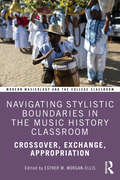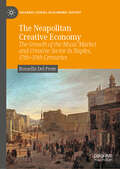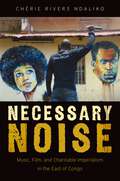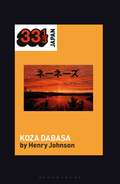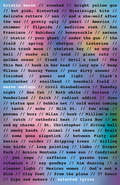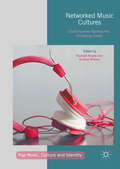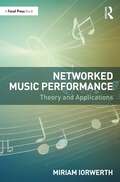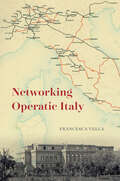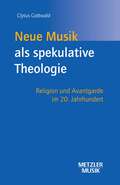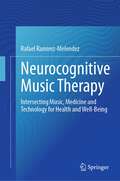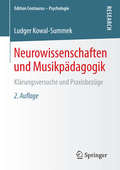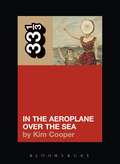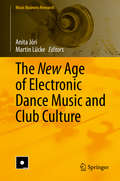- Table View
- List View
Navigating Stylistic Boundaries in the Music History Classroom: Crossover, Exchange, Appropriation (Modern Musicology and the College Classroom)
by Esther M. Morgan-EllisAt a time of transformation in the music history classroom and amid increasing calls to teach a global music history, Navigating Stylistic Boundaries in the Music History Classroom adds nuance to the teaching of varied musical traditions by examining the places where they intersect and the issues of musical exchange and appropriation that these intersections raise. Troubling traditional boundaries of genre and style, this collection of essays helps instructors to denaturalize the framework of Western art music and invite students to engage with other traditions—vernacular, popular, and non-Western—on their own terms.The book draws together contributions by a wide range of active scholars and educators to investigate the teaching of music history around cases of stylistic borders, exploring the places where different practices of music and values intersect. Each chapter in this collection considers a specific case in which an artist or community engages in what might be termed musical crossover, exchange, or appropriation and delves deeper into these concepts to explore questions of how musical meaning changes in moving across worlds of practice. Addressing works that are already widely taught but presenting new ways to understand and interpret them, this volume enables instructors to enrich the perspectives on music history that they present and to take on the challenge of teaching a more global music history without flattening the differences between traditions.
Navigating Stylistic Boundaries in the Music History Classroom: Crossover, Exchange, Appropriation (Modern Musicology and the College Classroom)
At a time of transformation in the music history classroom and amid increasing calls to teach a global music history, Navigating Stylistic Boundaries in the Music History Classroom adds nuance to the teaching of varied musical traditions by examining the places where they intersect and the issues of musical exchange and appropriation that these intersections raise. Troubling traditional boundaries of genre and style, this collection of essays helps instructors to denaturalize the framework of Western art music and invite students to engage with other traditions—vernacular, popular, and non-Western—on their own terms.The book draws together contributions by a wide range of active scholars and educators to investigate the teaching of music history around cases of stylistic borders, exploring the places where different practices of music and values intersect. Each chapter in this collection considers a specific case in which an artist or community engages in what might be termed musical crossover, exchange, or appropriation and delves deeper into these concepts to explore questions of how musical meaning changes in moving across worlds of practice. Addressing works that are already widely taught but presenting new ways to understand and interpret them, this volume enables instructors to enrich the perspectives on music history that they present and to take on the challenge of teaching a more global music history without flattening the differences between traditions.
The Neapolitan Creative Economy: The Growth of the Music Market and Creative Sector in Naples, 17th–19th Centuries (Palgrave Studies in Economic History)
by Rossella Del PreteThis book analyses the emergence and growth of the creative sector in Naples between the early modern and modern eras, focusing particularly on the development of music markets in the city. From the seventeenth century, Naples became one of the most culturally enriched regions in the Italian peninsula, with internationally known music schools, theatres and opera venues attracting visitors from across Europe in a burgeoning tourist market. This book sheds light on the driving economic factors and political contexts behind this key case study for the early growth of the opera and music sector in Europe. Starting with a discussion of the value of economic history to understanding cultural industries, the chapters approach this analysis through multiple lenses: the formation of human capital as the result of Naples’ institutional urban welfare system; the role of cultural consumption as it evolved from a primarily religious activity to growing popular demand; and the rolethat central city authorities played in encouraging cultural activity through private investment and public policy. The book also draws on fascinating archival research to examine the contribution of Naples’ music conservatories in the local creative economy. This book is a valuable resource to a broad range of readers, including those working in economic history, tourism history, the history of music and theatre, Italian social history and more.
Necessary Noise: Music, Film, and Charitable Imperialism in the East of Congo
by Chérie Rivers NdalikoSince 1997, the war in the east of the Democratic Republic of the Congo has taken more than 6 million lives and shapes the daily existence of the nation's residents. While the DRC is often portrayed in international media as an unproductive failed state, the Congolese have turned increasingly to art-making to express their experience to external eyes. Author Chérie Rivers Ndaliko argues that cultural activism and the enthusiasm to produce art exists in Congo as a remedy for the social ills of war and as a way to communicate a positive vision of the country. Ndaliko introduces a memorable cast of artists, activists, and ordinary people from the North-Kivu province, whose artistic and cultural interventions are routinely excluded from global debates that prioritize economics, politics, and development as the basis of policy decision about Congo. Rivers also shows how art has been mobilized by external humanitarian and charitable organizations, becoming the vehicle through which to inflict new kinds of imperial domination. Written by a scholar and activist in the center of the current public policy debate, Necessary Noise examines the uneasy balance of accomplishing change through art against the unsteady background of war. At the heart of this book is the Yole!Africa cultural center, which is the oldest independent cultural center in the east of Congo. Established in the aftermath of volcano Nyiragongo's 2002 eruption and sustained through a series of armed conflicts, the cultural activities organized by Yole!Africa have shaped a generation of Congolese youth into socially and politically engaged citizens. By juxtaposing intimate ethnographic, aesthetic, and theoretical analyses of this thriving local initiative with case studies that expose the often destructive underbelly of charitable action, Necessary Noise introduces into heated international debates on aid and sustainable development a compelling case for the necessity of arts and culture in negotiating sustained peace. Through vivid descriptions of a community of young people transforming their lives through art, Ndaliko humanizes a dire humanitarian disaster. In so doing, she invites readers to reflect on the urgent choices we must navigate as globally responsible citizens. The only study of music or film culture in the east of Congo, Necessary Noise raises an impassioned and vibrantly interdisciplinary voice that speaks to the theory and practice of socially engaged scholarship.
NECESSARY NOISE C: Music, Film, and Charitable Imperialism in the East of Congo
by Chérie Rivers NdalikoSince 1997, the war in the east of the Democratic Republic of the Congo has taken more than 6 million lives and shapes the daily existence of the nation's residents. While the DRC is often portrayed in international media as an unproductive failed state, the Congolese have turned increasingly to art-making to express their experience to external eyes. Author Chérie Rivers Ndaliko argues that cultural activism and the enthusiasm to produce art exists in Congo as a remedy for the social ills of war and as a way to communicate a positive vision of the country. Ndaliko introduces a memorable cast of artists, activists, and ordinary people from the North-Kivu province, whose artistic and cultural interventions are routinely excluded from global debates that prioritize economics, politics, and development as the basis of policy decision about Congo. Rivers also shows how art has been mobilized by external humanitarian and charitable organizations, becoming the vehicle through which to inflict new kinds of imperial domination. Written by a scholar and activist in the center of the current public policy debate, Necessary Noise examines the uneasy balance of accomplishing change through art against the unsteady background of war. At the heart of this book is the Yole!Africa cultural center, which is the oldest independent cultural center in the east of Congo. Established in the aftermath of volcano Nyiragongo's 2002 eruption and sustained through a series of armed conflicts, the cultural activities organized by Yole!Africa have shaped a generation of Congolese youth into socially and politically engaged citizens. By juxtaposing intimate ethnographic, aesthetic, and theoretical analyses of this thriving local initiative with case studies that expose the often destructive underbelly of charitable action, Necessary Noise introduces into heated international debates on aid and sustainable development a compelling case for the necessity of arts and culture in negotiating sustained peace. Through vivid descriptions of a community of young people transforming their lives through art, Ndaliko humanizes a dire humanitarian disaster. In so doing, she invites readers to reflect on the urgent choices we must navigate as globally responsible citizens. The only study of music or film culture in the east of Congo, Necessary Noise raises an impassioned and vibrantly interdisciplinary voice that speaks to the theory and practice of socially engaged scholarship.
Nellie: The Life and Loves of a Diva
by Robert WainwrightNellie Melba is remembered as a squarish, late middle-aged woman dressed in furs and large hats, an imperious Dame whose voice ruled the world for three decades and inspired a peach and raspberry dessert. But to succeed, she had to battle social expectations and misogyny that would have preferred she stay a housewife in outback Queensland rather than parade herself on stage. She endured the violence of a bad marriage, was denied by scandal a true love with the would-be King of France, and suffered for more than a decade the loss of her only son - stolen by his angry, vengeful father. Despite these obstacles, she built and maintained a career as an opera singer and businesswoman on three continents which made her one of the first international superstars. Award-winning biographer Robert Wainwright presents a very different portrait of this great diva, one that celebrates both her musical contributions and her rich and colourful personal life.
Nenes' Koza Dabasa: Okinawa in the World Music Market (33 1/3 Japan)
by Henry JohnsonKoza Dabasa explores Okinawa's island culture and its ghosts of war through the lens of Nenes, a four-woman pop group that draws on the distinctiveness and exoticism of Okinawan musical tradition. Both a tropical island paradise and the site of some of the bloodiest battles of World War II, Okinawa has a unique culture and a contentious history. Its musical traditions are distinct from other parts of Japan, varying in instrumentation, poetic forms, and musical scales. Nenes marks its cultural difference as Okinawan by emphasizing its own exoticism, expressed through its music, fashion, imagery, and performance style. Henry Johnson listens to Koza Dabasa as a representation of Okinawa's relationship with the Japanese music industry and with the broader themes of international warfare and local tourism.33 1/3 Global, a series related to but independent from 33 1/3, takes the format of the original series of short, music-based books and brings the focus to music throughout the world. With initial volumes focusing on Japanese and Brazilian music, the series will also include volumes on the popular music of Australia/Oceania, Europe, Africa, the Middle East, and more.
Nenes' Koza Dabasa: Okinawa in the World Music Market (33 1/3 Japan)
by Henry JohnsonKoza Dabasa explores Okinawa's island culture and its ghosts of war through the lens of Nenes, a four-woman pop group that draws on the distinctiveness and exoticism of Okinawan musical tradition. Both a tropical island paradise and the site of some of the bloodiest battles of World War II, Okinawa has a unique culture and a contentious history. Its musical traditions are distinct from other parts of Japan, varying in instrumentation, poetic forms, and musical scales. Nenes marks its cultural difference as Okinawan by emphasizing its own exoticism, expressed through its music, fashion, imagery, and performance style. Henry Johnson listens to Koza Dabasa as a representation of Okinawa's relationship with the Japanese music industry and with the broader themes of international warfare and local tourism.33 1/3 Global, a series related to but independent from 33 1/3, takes the format of the original series of short, music-based books and brings the focus to music throughout the world. With initial volumes focusing on Japanese and Brazilian music, the series will also include volumes on the popular music of Australia/Oceania, Europe, Africa, the Middle East, and more.
Nerve Endings: Selected Lyrics
by Kristin HershSince forming the seminal art rock band Throwing Muses while still in her teens, Kristin Hersh has been at the forefront of alternative music, acclaimed for her raw, visceral and poetic songwriting.Here, collected for the first time, are the lyrics to one hundred songs, curated by the woman who wrote them. From Throwing Muses classics like ‘Bright Yellow Gun’ to solo material such as ‘Your Ghost’ and her songs with 50 Foot Wave, Nerve Endings encapsulates one of the most fascinating and honest careers in modern rock music.
Networked Music Cultures: Contemporary Approaches, Emerging Issues (Pop Music, Culture and Identity)
by Raphaël Nowak Andrew WhelanThis collection presents a range of essays on contemporary music distribution and consumption patterns and practices. The contributors to the collection use a variety of theoretical and methodological approaches, discussing the consequences and effects of the digital distribution of music as it is manifested in specific cultural contexts.The widespread circulation of music in digital form has far-reaching consequences: not least for how we understand the practices of sourcing and consuming music, the political economy of the music industries, and the relationships between format and aesthetics. Through close empirical engagement with a variety of contexts and analytical frames, the contributors to this collection demonstrate that the changes associated with networked music are always situationally specific, sometimes contentious, and often unexpected in their implications. With chapters covering topics such as the business models of streaming audio, policy and professional discourses around the changing digital music market, the creative affordances of format and circulation, and local practices of accessing and engaging with music in a range of distinct cultural contexts, the book presents an overview of the themes, topics and approaches found in current social and cultural research on the relations between music and digital technology.
Networked Music Performance: Theory and Applications
by Miriam IorwerthNetworked Music Performance (NMP) is the essential guide to both playing music online and ensemble music through networks. Offering a range of case studies, from highly technical solutions to inclusive community projects, this book provides inspiration to musicians to try NMP whatever their level of technical expertise. Drawing upon recent research to examine the background and history of the practice as well as specific practical approaches, technical and musical considerations are included for readers, as are ideas around accessibility and creativity. Accessibility is considered in the context of the opportunities that NMP gives to musicians working remotely, as well as some of the barriers to participation in NMP and how these can be overcome. Synchronous and asynchronous approaches to NMP are explored in detail, examining the technical and musical affordances and challenges of working remotely for musicians. Networked Music Performance will appeal to music and music technology students as well as professional musicians and technicians who have started working online and wish to improve their practice. As NMP in the context of music education and community music are also explored, this book supplies educators and community leaders with knowledge and practical guidance on how to move their practice online.
Networked Music Performance: Theory and Applications
by Miriam IorwerthNetworked Music Performance (NMP) is the essential guide to both playing music online and ensemble music through networks. Offering a range of case studies, from highly technical solutions to inclusive community projects, this book provides inspiration to musicians to try NMP whatever their level of technical expertise. Drawing upon recent research to examine the background and history of the practice as well as specific practical approaches, technical and musical considerations are included for readers, as are ideas around accessibility and creativity. Accessibility is considered in the context of the opportunities that NMP gives to musicians working remotely, as well as some of the barriers to participation in NMP and how these can be overcome. Synchronous and asynchronous approaches to NMP are explored in detail, examining the technical and musical affordances and challenges of working remotely for musicians. Networked Music Performance will appeal to music and music technology students as well as professional musicians and technicians who have started working online and wish to improve their practice. As NMP in the context of music education and community music are also explored, this book supplies educators and community leaders with knowledge and practical guidance on how to move their practice online.
Networking Operatic Italy (Opera Lab: Explorations in History, Technology, and Performance)
by Francesca VellaA study of the networks of opera production and critical discourse that shaped Italian cultural identity during and after Unification. Opera’s role in shaping Italian identity has long fascinated both critics and scholars. Whereas the romance of the Risorgimento once spurred analyses of how individual works and styles grew out of and fostered specifically “Italian” sensibilities and modes of address, more recently scholars have discovered the ways in which opera has animated Italians’ social and cultural life in myriad different local contexts. In Networking Operatic Italy, Francesca Vella reexamines this much-debated topic by exploring how, where, and why opera traveled on the mid-nineteenth-century peninsula, and what this mobility meant for opera, Italian cities, and Italy alike. Focusing on the 1850s to the 1870s, Vella attends to opera’s encounters with new technologies of transportation and communication, as well as its continued dissemination through newspapers, wind bands, and singing human bodies. Ultimately, this book sheds light on the vibrancy and complexity of nineteenth-century Italian operatic cultures, challenging many of our assumptions about an often exoticized country.
Networking Operatic Italy (Opera Lab: Explorations in History, Technology, and Performance)
by Francesca VellaA study of the networks of opera production and critical discourse that shaped Italian cultural identity during and after Unification. Opera’s role in shaping Italian identity has long fascinated both critics and scholars. Whereas the romance of the Risorgimento once spurred analyses of how individual works and styles grew out of and fostered specifically “Italian” sensibilities and modes of address, more recently scholars have discovered the ways in which opera has animated Italians’ social and cultural life in myriad different local contexts. In Networking Operatic Italy, Francesca Vella reexamines this much-debated topic by exploring how, where, and why opera traveled on the mid-nineteenth-century peninsula, and what this mobility meant for opera, Italian cities, and Italy alike. Focusing on the 1850s to the 1870s, Vella attends to opera’s encounters with new technologies of transportation and communication, as well as its continued dissemination through newspapers, wind bands, and singing human bodies. Ultimately, this book sheds light on the vibrancy and complexity of nineteenth-century Italian operatic cultures, challenging many of our assumptions about an often exoticized country.
Networks of Music and Culture in the Late Sixteenth and Early Seventeenth Centuries: A Collection of Essays in Celebration of Peter Philips’s 450th Anniversary
by David J. Smith Rachelle TaylorPeter Philips (c.1560-1628) was an English organist, composer, priest and spy. He was embroiled in multifarious intersecting musical, social, religious and political networks linking him with some of the key international players in these spheres. Despite the undeniable quality of his music, Philips does not fit easily into an overarching, progressive view of music history in which developments taking place in centres judged by historians to be of importance are given precedence over developments elsewhere, which are dismissed as peripheral. These principal loci of musical development are given prominence over secondary ones because of their perceived significance in terms of later music. However, a consideration of the networks in which Philips was involved suggests that he was anything but at the periphery of the musical, cultural, religious and political life of his day. In this book, Philips’s life and music serve as a touchstone for a discussion of various kinds of network in the late sixteenth and early seventeenth centuries. The study of networks enriches our appreciation and understanding of musicians and the context in which they worked. The wider implication of this approach is a constructive challenge to orthodox historiographies of Western art music in the Early Modern Period.
Networks of Music and Culture in the Late Sixteenth and Early Seventeenth Centuries: A Collection of Essays in Celebration of Peter Philips’s 450th Anniversary
by David J. Smith Rachelle TaylorPeter Philips (c.1560-1628) was an English organist, composer, priest and spy. He was embroiled in multifarious intersecting musical, social, religious and political networks linking him with some of the key international players in these spheres. Despite the undeniable quality of his music, Philips does not fit easily into an overarching, progressive view of music history in which developments taking place in centres judged by historians to be of importance are given precedence over developments elsewhere, which are dismissed as peripheral. These principal loci of musical development are given prominence over secondary ones because of their perceived significance in terms of later music. However, a consideration of the networks in which Philips was involved suggests that he was anything but at the periphery of the musical, cultural, religious and political life of his day. In this book, Philips’s life and music serve as a touchstone for a discussion of various kinds of network in the late sixteenth and early seventeenth centuries. The study of networks enriches our appreciation and understanding of musicians and the context in which they worked. The wider implication of this approach is a constructive challenge to orthodox historiographies of Western art music in the Early Modern Period.
Neue Deutsche Welle (Genre: A 33 1/3 Series)
by Claudia LonkinNeue Deutsche Welle (NDW), or “German New Wave,” was made extraordinarily popular in the 1970s and 1980s by the likes of Nena's "99 Luftballoons" and Trio's "Da Da Da"-and then left as quickly as it came. Conventional wisdom among artists dictates that it's better to burn out than fade away, but this doesn't tell the full story of NDW-the reason for its rapid rise and fall, the historical context that necessitated the genre, and where the energy of the NDW movement went after its end. The genre has international influences but still demonstrates a uniquely German desire to build a new, sanitized identity in the aftermath of World War II. Originally quite subversive and underground, NDW became exponentially more mainstream until it could no longer sustain itself creatively. And rather than disappearing, it helped give rise to the post-Cold War rave craze and is still an important touchstone in music history.
Neue Deutsche Welle (Genre: A 33 1/3 Series)
by Claudia LonkinNeue Deutsche Welle (NDW), or “German New Wave,” was made extraordinarily popular in the 1970s and 1980s by the likes of Nena's "99 Luftballoons" and Trio's "Da Da Da"-and then left as quickly as it came. Conventional wisdom among artists dictates that it's better to burn out than fade away, but this doesn't tell the full story of NDW-the reason for its rapid rise and fall, the historical context that necessitated the genre, and where the energy of the NDW movement went after its end. The genre has international influences but still demonstrates a uniquely German desire to build a new, sanitized identity in the aftermath of World War II. Originally quite subversive and underground, NDW became exponentially more mainstream until it could no longer sustain itself creatively. And rather than disappearing, it helped give rise to the post-Cold War rave craze and is still an important touchstone in music history.
Neue Musik als spekulative Theologie: Religion und Avantgarde im 20. Jahrhundert
by Clytus GottwaldGeistliche Musik des 20. Jahrhunderts. An der Schnittstelle von Philosophie, Religion und Komposition arbeiten die Autoren jene umfassende Reflexivität heraus, durch die Neue Musik zur spekulativen Theologie wird. Die brillante Argumentation reicht dabei von Strawinsky, Penderecki und Bernd Alois Zimmermann bis zu Lachenmann, Messiaen und Stockhausen.
Neurocognitive Music Therapy: Intersecting Music, Medicine and Technology for Health and Well-Being
by Rafael Ramírez-MeléndezFor thousands of years, music has acted as a powerful medium for evoking emotions, facilitating communication, and nurturing overall well-being. With the advent of new sophisticated neuroimaging technology, human responses to music and music therapy are being viewed through a new lens. As a consequence, new knowledge is being obtained about how music can produce significant improvements in cognitive, social, overt and agitated behaviours. The aim of this book is to provide an overview of neurocognitive music therapy, its impact and implications in the practice of evidence-based music interventions. The book seeks to provide researchers, psychologists, music therapists, musicians and physicians interested in the therapeutic applications of music, with a source of information about current techniques and novel music interventions. It is structured into several chapters, each of them presenting peer-reviewed research and evidence-based procedures carried out in a specific clinical context. Topics covered in the book include: Musical engagement for individuals with motor disabilities Enhancing emotional processing in autism through music Stroke rehabilitation via musical interventions Musical neurofeedback for emotional disorders Emotional modulation with music therapy in palliative care AI-driven personalisation in music interventionsThe book highlights the profound capacity of music-based interventions to facilitate cognitive and emotional processing, enhance communication, and promote motor rehabilitation. At the same time, the book demonstrates how modern technologies offer new opportunities to evaluate, validate, and potentiate music-based interventions, allowing new and innovative possibilities and more personalised interventions. This book aims to contribute to the growing body of knowledge in this field and inspire further research and innovation in the practice of music therapy.
Neurowissenschaften und Musikpädagogik: Klärungsversuche und Praxisbezüge (Edition Centaurus – Psychologie)
by Ludger Kowal-SummekLudger Kowal-Summek erläutert in diesem Buch, was Musikpädagogen von der Hirnforschung und der Psychologie lernen können. Es wird eine wissenschaftlich-kritische Analyse dessen durchgeführt, was die Musikpädagogik von der Neurowissenschaft realistischerweise erwarten kann, sowie die Möglichkeiten und Grenzen der Übertragung von Wissen aus benachbarten Disziplinen am Beispiel des Verstehens und der Vermittlung musikalischer Inhalte neu austariert. Dabei bereitet der Autor die Untersuchung so auf, dass diese auch dem Laien verständlich wird.
Neurowissenschaften und Musikpädagogik: Klärungsversuche und Praxisbezüge (Edition Centaurus – Psychologie)
by Ludger Kowal-SummekLudger Kowal-Summek erläutert in diesem Buch, was Musikpädagogen von der Hirnforschung und der Psychologie lernen können. Es wird eine wissenschaftlich-kritische Analyse dessen durchgeführt, was die Musikpädagogik von der Neurowissenschaft realistischerweise erwarten kann, sowie die Möglichkeiten und Grenzen der Übertragung von Wissen aus benachbarten Disziplinen am Beispiel des Verstehens und der Vermittlung musikalischer Inhalte neu austariert. Dabei bereitet der Autor die Untersuchung so auf, dass diese auch dem Laien verständlich wird.
Neutral Milk Hotel's In the Aeroplane Over the Sea (33 1/3)
by Kim CooperOf all the recordings to emerge from the Athens-via-Denver collective called Elephant 6, Neutral Milk Hotel's second album is the one that has worked its way under the most skins. Magnet magazine named it the best album of the 1990s, and Creative Loafing recently devoted a cover story to one fan's quest to understand why band leader Jeff Mangum dropped outof sight soon after Aeroplane's release. The record sells steadily to an audience that finds it through word of mouth. Weird, beautiful, absorbing, difficult, In The Aeroplane Over the Seais a surrealist text loosely based on the life, suffering and reincarnation of Anne Frank, with guest appearances from a pair ofSiamese twins menaced by the cold and carnivores, a two-headed boy bobbing in a jar, anthropomorphic vegetables and a variety of immature erotic horrors. Mangum sings his dreamlike narratives with a dreamer's intensity, his creaky, off key voice occasionally breaking as he struggles to complete each dense couplet. The music is like nothing else in the 90s indie underground: a psychedelic brass band, its members self-taught, forging polychromatic washes of mood and tribute. The songs stick to one narrow key, the images repeat and circle back, and to listen is to be absorbed into a singular, heart-rending vision.
Neutral Milk Hotel's In the Aeroplane Over the Sea (33 1/3)
by Kim CooperOf all the recordings to emerge from the Athens-via-Denver collective called Elephant 6, Neutral Milk Hotel's second album is the one that has worked its way under the most skins. Magnet magazine named it the best album of the 1990s, and Creative Loafing recently devoted a cover story to one fan's quest to understand why band leader Jeff Mangum dropped outof sight soon after Aeroplane's release. The record sells steadily to an audience that finds it through word of mouth. Weird, beautiful, absorbing, difficult, In The Aeroplane Over the Seais a surrealist text loosely based on the life, suffering and reincarnation of Anne Frank, with guest appearances from a pair ofSiamese twins menaced by the cold and carnivores, a two-headed boy bobbing in a jar, anthropomorphic vegetables and a variety of immature erotic horrors. Mangum sings his dreamlike narratives with a dreamer's intensity, his creaky, off key voice occasionally breaking as he struggles to complete each dense couplet. The music is like nothing else in the 90s indie underground: a psychedelic brass band, its members self-taught, forging polychromatic washes of mood and tribute. The songs stick to one narrow key, the images repeat and circle back, and to listen is to be absorbed into a singular, heart-rending vision.
The New Age of Electronic Dance Music and Club Culture (Music Business Research)
by Martin Lücke Anita JóriThis book offers a comprehensive overview of electronic dance music (EDM) and club culture. To do so, it interlinks a broad range of disciplines, revealing their (at times vastly) differing standpoints on the same subject. Scholars from such diverse fields as cultural studies, economics, linguistics, media studies, musicology, philosophy, and sociology share their perspectives. In addition, the book features articles by practitioners who have been active on the EDM scene for many years and discuss issues like gender and diversity problems in general, and the effects of gentrification on club culture in Berlin. Although the book’s main focus is on Berlin, one of the key centers of EDM and club culture, its findings can also be applied to other hotspots. Though primarily intended for researchers and students, the book will benefit all readers interested in obtaining an interdisciplinary overview of research on electronic dance music.
